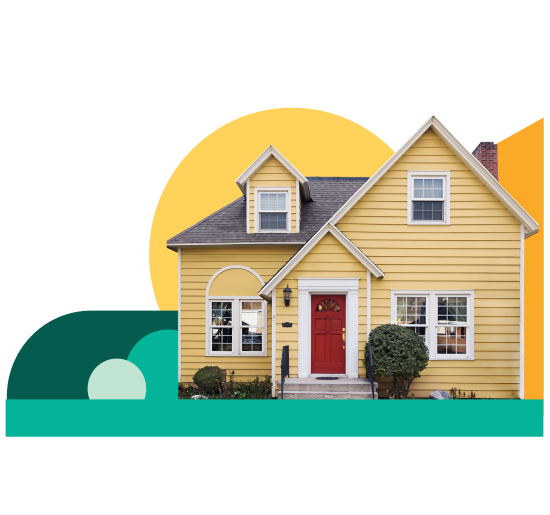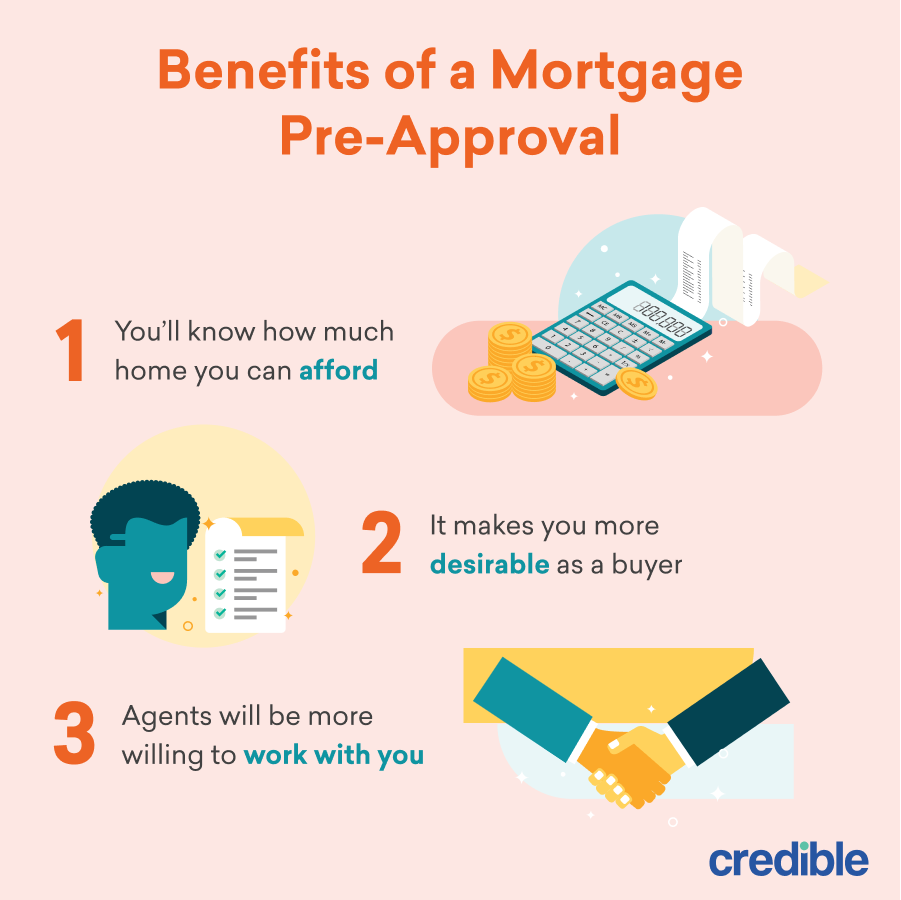Our goal is to give you the tools and confidence you need to improve your finances. Although we receive compensation from our partner lenders, whom we will always identify, all opinions are our own. Credible Operations, Inc. NMLS # 1681276, is referred to here as "Credible."
Getting pre-approved is a key step in the homebuying process. Once you’re pre-approved by a lender, you’ll receive a mortgage pre-approval letter, which shows how much you’re qualified to borrow. It also demonstrates to the seller that you’re a serious buyer.
Here’s what you need to know when seeking mortgage pre-approval:
- What is a mortgage pre-approval?
- How to get pre-approved for a mortgage
- Mortgage prequalification vs. pre-approval
- Pre-approval vs. approval
- Why should I get pre-approved?
- What does a mortgage pre-approval letter say?
- What are the benefits of having a mortgage pre-approval?
- When should I get pre-approved for a mortgage?
- How long does a mortgage pre-approval last?
- Will getting pre-approved by multiple lenders hurt my credit score?
What is a mortgage pre-approval?
A mortgage pre-approval is a letter from a mortgage lender or broker that details how much money a lender is able to lend to you, based on certain assumptions about your creditworthiness and credit history.
For example, a lender or broker might say that, based on your current credit score and income, the pre-approval letter supports a mortgage up to $250,000 in value.
In the pre-approval letter, you’ll see an estimate of your mortgage loan amount, interest rate, and what your monthly payment would be, based on the assumptions made regarding your creditworthiness and credit history.
To decide whether or not to issue a mortgage pre-approval, lenders or brokers typically assess the following information:
- Assets: How much you have in assets, including cash in your checking or savings account, stocks and bonds, and real estate
- Income: Whether your income is sufficient to cover the cost of your mortgage — typically, they’re looking to see that you have a debt-to-income ratio (DTI) below 50%, but ideally, your DTI is 43% or below
- Credit history: Credit check to review your credit report (the lowest interest rates are reserved for those with excellent credit)
How to get pre-approved for a mortgage
With some preparation and homework, the mortgage pre-approval process can be a breeze. To get pre-approved, you’ll want to take these five easy steps.
- Budget for a down payment
- Gather the information you’ll need
- Comparison shop with multiple lenders
- Limit your debt and stay current on your bills
- Submit your loan application
1. Budget for a down payment
The more money you can put down, the lower the interest rate and monthly payments will be. If you put down less than 20% of the home’s purchase price, you’ll have to pay for private mortgage insurance (PMI) on top of the cost of the home loan.
The type of mortgage you apply for will affect how much of a down payment you’ll need. For example, for most mortgages, you’ll need to put down 3% to 20%. But if you qualify for a Federal Housing Administration (FHA) loan, you can put down just 3.5%.
Credible’s monthly mortgage payment calculator makes this easy. Simply enter your loan information below to see how much you’ll pay monthly and over the life of the loan.
Enter your loan information to calculate how much you could pay
With a $ home loan, you will pay $ monthly and a total of $ in interest over the life of your loan. You will pay a total of $ over the life of the mortgage.
2. Gather the information you’ll need
Depending on where you get your pre-approval letter, traditional lenders require you to upload your documents upfront.
Here’s some of the information you should have ready:
Learn More: Your Mortgage Pre-Approval Checklist: Every Document You’ll Need
3. Comparison shop with multiple lenders
It’s a good idea to compare offers from several different lenders to ensure you get the lowest mortgage rates.
Credible makes finding a mortgage easy
Compare prequalified mortgage rates from top lenders in just 3 minutes.
4. Limit your debt and stay current on your bills
Your pre-approval is dependent on several factors, such as your:
- Credit score: Before getting pre-approved, keep your credit score healthy by making all of your payments on time and keeping your credit card and loan balances low. Keep up these habits throughout the mortgage process.
- Debt: You may also want to pay off debts, if possible, to lower your debt-to-income ratio. A high DTI ratio reduces how much you can borrow on a mortgage, which influences your pre-approval letter.
- Income: Lenders also check your income by looking over your pay stubs, tax returns, and W-2 forms. Try not to change employers or alter your income before getting a pre-approval and during the mortgage process.
- Down payment: If you can afford to put down a large down payment, it shrinks the amount you need to borrow and reduces risk for the lender. This may improve your chances of qualifying for a mortgage and getting good loan terms.
- Employment history: Lenders might not check your employment history during the pre-approval process. Just keep in mind they will eventually call your employer to ask about your employment history and inquire about the likelihood of continued employment.
5. Submit your loan application
Once the offer on your house is accepted, you can apply for a home loan.
Getting pre-approved for a mortgage can make you a more desirable buyer, and can give you an idea of how much you can really afford to spend on a home, depending on your financial situation.
By following the above steps, you can navigate through the process smoothly and be on your way to buying your dream home.
Mortgage prequalification vs. pre-approval
Prequalification is usually better for buyers who have not yet started looking at properties. But if you’re serious about buying, you should probably work on getting pre-approved.
Generally, getting prequalified for a mortgage is less involved than a “full” mortgage pre-approval. Here’s a comparison of the two:
| Prequalification | Pre-approval | |
| Hard credit inquiry | No | Yes |
| Shows exactly what you can afford | No, just an estimate | Yes |
| Sellers usually want to see it | No | Yes |
| Financial documents and information needed | No | Yes |
Learn More: Mortgage Pre-Approval vs. Prequalification: Which Should You Get?
Pre-approval vs. approval
Pre-approval and approval are two different stages of the homebuying process. When a lender runs a pre-approval, they’ll check your credit, assets, income, and employment status. But the pre-approval isn’t a binding agreement, so it doesn’t guarantee you a mortgage.
Approval comes after you’ve found a home and submitted a mortgage application. The lender checks your financial situation again and orders an appraisal to verify the value of the home you’re buying. If you pass these underwriting steps, the lender will approve your home loan and move you to the closing table.
Why should I get pre-approved?
There are several ways a pre-approval can help you during the homebuying process. Because a pre-approval letter tells you how much you can borrow, it can help guide your budget. You can tailor your search to homes within that price range.
A pre-approval letter also shows sellers you’re a serious borrower. When you submit a purchase offer and include a pre-approval letter, the seller knows a lender has verified your information. There are fewer chances you’ll run into problems getting the loan, which can help you stand out in a competitive housing market.
Plus, the pre-approval process may help you uncover potential issues before you get to the underwriting stage later on. For instance, you might find an error on your credit report. It’s better to deal with these issues upfront.
What does a mortgage pre-approval letter say?
A mortgage pre-approval letter shows you how much a lender is willing to let you borrow. It’ll typically include the following information:
- Purchase price
- Loan amount
- Loan type
- Down payment
- Expiration date
- Interest rate
What are the benefits of having a mortgage pre-approval?
Qualifying for a mortgage pre-approval has several benefits:
- You’ll know how much home you can afford. Having a pre-approval can give you a solid idea of how much home you can really afford, especially as a first-time homebuyer. That can help you narrow down your home search, so you don’t stretch your budget too far.
- It makes you more desirable. If you’re considering putting an offer on a house, having a mortgage pre-approval is essential. Otherwise, you risk being overlooked because home sellers won’t see you as a serious buyer and will choose someone else.
- Agents will be more willing to work with you. Many real estate agents won’t work with buyers who don’t have pre-approval letters, putting you at a huge disadvantage.
When should I get pre-approved for a mortgage?
The best time to get pre-approved for a mortgage is when you’re just starting the homebuying process. Typically, this will be before you start looking for a house or while you’re starting to shop around.
Basically, when you’re serious about buying a home, it’s a good idea to get pre-approved.
How long does a mortgage pre-approval last?
Depending on the lender, your pre-approval might only be valid for about 30 days — though it’s usually valid for at least 90 days. If it’s taking you longer to find the house you wish to buy, you might need to request multiple pre-approval letters over that time.
Will getting pre-approved by multiple lenders hurt my credit score?
If you decide to get a mortgage pre-approval from a bank, it will require a hard credit inquiry and that can affect your credit score.
Chris Jennings, Jamie Young, and Kim Porter contributed to the reporting in this article.


